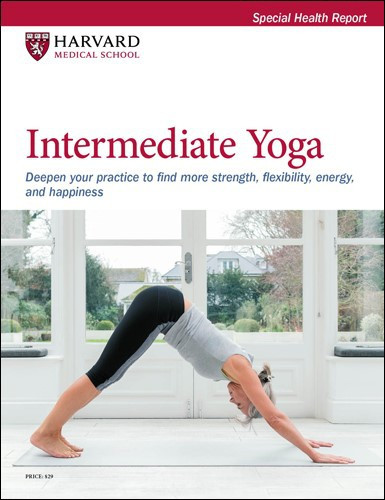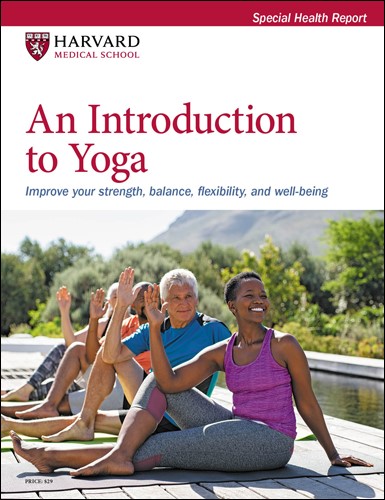
Celiac disease: Exploring four myths

What is prostatitis and how is it treated?

What is Cushing syndrome?

Exercises to relieve joint pain

Think your child has ADHD? What your pediatrician can do

Foam roller: Could you benefit from this massage tool?

Stepping up activity if winter slowed you down

Common causes of cloudy urine

Dragon fruit: How to enjoy this antioxidant-rich fruit

Are you getting health care you don't need?


Intermediate Yoga
Step-by-step, Intermediate Yoga reveals 6 straight-forward practices specifically geared to help enhance flexibility, improve your balance, build strength, boost your energy, and ease stress and tension, all in the comfort of your home. These yoga practices are NOT about doing more and working harder. They’re more about undoing—relaxing, releasing and letting go. They build on basic yoga poses and breathing techniques and offer you a slow and steady route to better health and fitness that can make a world of difference.
Other Product Information
Now, you can put centuries of proven healing success into practice with Intermediate Yoga—the Special Health Report from Harvard Medical School. Step-by-step, this guide reveals 6 straight-forward practices specifically geared to help enhance flexibility, improve your balance, build strength, boost your energy, and ease stress and tension, all in the comfort of your home.
These yoga practices are NOT about doing more and working harder. They’re more about undoing—relaxing, releasing and letting go. They build on basic yoga poses and breathing techniques and offer you a slow and steady route to better health and fitness that can make a world of difference.
Easy directions plus full-color, how-to photos show you how to get maximum benefit from each yoga practice.
For example, in the morning, you may want to try the Energizing Practice (page 41). Later on, after a tough day, you might prefer the Calming Practice (page 44). If you’re feeling stiff or you need to improve the range of motion in certain joints, the Flexibility Practice (page 28) may be just the ticket.
The Strengthening Practice (page 38) helps build your muscles, which can be especially useful as you naturally start to lose muscle mass with the passage of time. Or you might need to work on your balance—a skill that tends to diminish with age—by working on the Balance Practice (page 33).
You’ll also discover a variety of breathing exercises that can calm, energize, or center you, along with a variety of mudras—hand positions used during breathing exercises or meditation to help bring your mind into focus. Thanks to easy-to-understand exercises in this Special Health Report, you will soon experience positive mind and body changes on your path to better health!
Prepared by Harvard Health Publishing in consultation with Darshan Mehta, MD, MPH, Medical Director, Benson-Henry Institute for Mind Body Medicine at Massachusetts General Hospital, Education Director, Osher Center for Integrative Medicine at Brigham and Women’s Hospital, Assistant Professor of Medicine, Harvard Medical School and Laura Malloy, LICSW, C-IAYT, Certified yoga teacher and yoga therapist, Director of Yoga, Benson-Henry Institute for Mind Body Medicine at Massachusetts General Hospital. 2021. 53 pages.
It tamps down stress. Stress that you encounter on a daily basis doesn’t just grind you down mentally. It also affects your physical health. Stress causes your body and brain to invoke the so-called fight-or-flight response — the classic stress response, which primes your body to deal with an immediate short-term threat in which you must fight an enemy or flee to safety. In the stress response, a flood of stress hormones increases your heart rate in order to pump more blood to muscles; it also releases more glucose into the bloodstream to fuel those muscles, ratchets up inflammation to deal with any potential wounds, and diverts the body’s resources away from functions like digestion, which are not needed for escaping the threat.
Its opposite, the relaxation response — sometimes referred as the rest-and-digest response — calms your body. It conserves and restores energy, slowing your heart rate and lowering your blood pressure. It’s responsible for maintaining functions such as digestion at the status quo. It’s active when you’re relaxed — and it’s enhanced by yoga. Many of the benefits of yoga are the result of stress reduction and its related effects on the body.
It reduces inflammation. As noted above, reducing stress can also dial back inflammation, which has been a major focus of research in recent years, as evidence increasingly shows its potential long-term harms. To be sure, short-term inflammation is essential for survival. If you cut yourself, it aids in fighting bacteria and healing the wound. But over the long term, lowgrade chronic inflammation is associated with a range of harmful effects, including the development of heart disease, diabetes, and cancer. A 2019 review of 15 yoga studies found that yoga reduced markers of inflammation.
It tones the vagus nerve. The vagus nerve winds from your brainstem down through your neck and the trunk of your body. One of 10 cranial nerves, it has been referred to as the body’s “air traffic controller” because it helps regulate all major bodily functions, including your breathing, heart rate, and digestion. The two-way message traffic it coordinates between the brain and the body has an important impact on your mood and emotional regulation.
The vagus nerve is a key component of your parasympathetic nervous system (the part that governs the relaxation response). Greater vagal tone — that is, greater activity of the vagus nerve — means that your body can shift more easily from the stress response to the relaxation response. Vagal tone can’t be measured directly. Instead, other biological processes — such as your heart rate during inhalations and exhalations — serve as indicators of vagal tone. When vagal tone is high, your heart is beating properly, your digestion is good, your moods are stable, and you’re able to handle challenges or stress and recover from it quickly, making you more resilient in the face of stress.
If you have low vagal tone, you’re more likely to have a high heart rate, sluggish digestion, a sense of being drained, and trouble controlling your moods and emotions. Conditions such as depression, chronic pain, and post-traumatic stress disorder are associated with low vagal tone. Yoga appears to increase vagal tone, providing a possible explanation for why these conditions respond well to yoga.
It increases immunity. By fighting stress and inflammation, yoga appears to improve your body’s natural defenses as well. Among other things, it raises levels of your body’s own antioxidants. Antioxidants neutralize free radicals (byproducts of the body’s energy production or of exposure to air pollution and ultraviolet rays), which cause oxidative stress that can damage DNA, cells, and tissues and lead to disease. In a review of 11 studies, published in the Journal of Complementary and Integrative Medicine, yoga improved antioxidant levels and reduced oxidative stress in healthy people as well as those with diabetes, prediabetes, high blood pressure, and kidney disease.
It regulates gene expression. A review of 18 studies found that mind-body practices such as yoga and meditation generally reduce the expression (activity) of genes linked to chronic low-grade inflammation — the kind of inflammation that contributes to many serious ailments, such as heart disease. In addition to tamping down the activity of a number of disease-promoting genes, mind-body practices appear to boost that of numerous health-promoting genes. One of the studies included in the review showed that a simple meditation practice could upregulate (activate) certain beneficial genes in both longtime practitioners and novices. While meditation had greater and more consistent effects on the genes of the experienced practitioners, the novices also saw positive changes after eight weeks of a daily practice, resulting in the enhanced expression of genes associated with energy metabolism, mitochondrial function, insulin secretion, and telomere maintenance (all good things).
It protects your genes. It may sound improbable, but research suggests that yoga could also help keep you young — or at least, keep your cells from aging quite as fast. The key is the length of your telomeres; these are repetitive stretches of DNA at the ends of chromosomes, which serve as protective caps, much like the plastic tips on the ends of shoelaces. Shorter telomeres are associated with disease and aging, and chronic stress is a culprit in this process. But dialing back stress through yoga may help protect your telomeres. Researchers found that doing a daily 12-minute yoga meditation increased the activity of telomerase (the enzyme that helps maintain and even rebuild telomeres) by 43%. This pilot study was published in the International Journal of Geriatric Psychiatry.
- The power of yoga
- What is yoga?
- The major components of yoga
- The health benefits of yoga
- Increased well-being
- Better physical health
- Better mental health
- Before you start: Safety first
- When to get a doctor’s approval
- Advice for people with arthritis
- Advice for people with high blood pressure
- Advice for people with osteoporosis
- Advice for people with glaucoma
- How to use the yoga practices in this report
- Equipment
- Terminology used in the routines
- Tips for a better, safer practice
- Equipment
- Basic Practice
- Flexibility Practice
- Balance Practice
- Strengthening Practice
- Energizing Practice
- Calming Practice
- SPECIAL SECTION:
- Expand your practice — finding the right class
- Resources
You might also be interested in…

Introduction to Yoga
Yoga is more than just a workout—it’s actually a combination of four components: postures (like tree pose), breathing practices, deep relaxation, and meditation that can transform your health on many different levels. To show you how easy yoga can be and how you can reap the many health benefits, Harvard Medical School experts created An Introduction to Yoga.

Celiac disease: Exploring four myths

What is prostatitis and how is it treated?

What is Cushing syndrome?

Exercises to relieve joint pain

Think your child has ADHD? What your pediatrician can do

Foam roller: Could you benefit from this massage tool?

Stepping up activity if winter slowed you down

Common causes of cloudy urine

Dragon fruit: How to enjoy this antioxidant-rich fruit

Are you getting health care you don't need?
Free Healthbeat Signup
Get the latest in health news delivered to your inbox!
Sign Up

